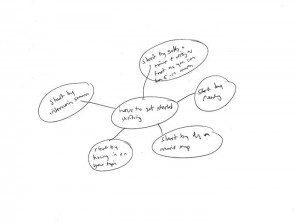Reading time: About 2.5 minutes
Need some advice on how to start writing? Professional trainers and time management executives all know that teaching people how to begin a task will often be enough to ensure they complete it. Read below for more detail.
In last week’s column I mentioned writing my thesis. Those memories weren’t happy. There I was, a 21-year-old student, and absolutely miserable. Getting that thesis out of me was like getting a sack of Christmas toys out of a room filled with four-year-olds. I resisted, and procrastinated and delayed. In fact, I might have cheerfully hacked off my right arm if you’d told me it meant I didn’t have to write anymore.
Now I think, “why did I make such big deal about that?” Well, the big deal was that I didn’t have any good strategies for getting started. I’d go through the card catalogue — in those days a seemingly never-ending set of oak drawers in a very large, drafty old building. I’d check out a pile of books and flip through them, making notes on little 3×5 cards. Occasionally I’d try making an outline. Then, well, then I’d sit and stew. I’d stare at the blank paper in my typewriter (no PCs in those days!) and wait for inspiration to hit. It seldom did.
How I wish I’d known about the following five easy strategies:
1) Start by reading. I know this sounds like procrastination 101, but it’s not if you do it the right way. The main idea is to find a piece of writing that provides a suitable model on which you can base your own work. Not only is this not procrastinating, it’s not even plagiarism provided you’re not looking for content. Instead you should be looking for style and writing architecture. For example, if you want to write a book, you should find another book that has a structure you really admire. If you want to produce a sales letter, you should have a collection of top-notch ones at hand. Copywriters call such samples a “swipe file.” Build your own swipe file and use it.
2) Start by making a mindmap. When you signed up for this newsletter you received a short e-booklet on mindmapping. Don’t forget to use this technique — it’s a little bit of magic. Here is the mindmap 
3) Start by honing in on your topic. Many writers run into difficulty when their subject is “too big” for the space they have. Avoid this problem by being very specific. If you have only 500 words you can’t write an exhaustive analysis of global warming. (Nor can you present interviews with 12 people. I once had a client who wanted me to do that. In 500 words!) But you can write about one’s company’s program to reduce fossil fuel dependence. Make sure your subject matches the length available.
4) Start by interviewing someone. I always prefer to find out facts by talking to people rather than by reading. First of all, I usually get more interesting stuff that way. Second, it’s often faster. Third, I can ask questions when I don’t understand.
5) Start by setting a timer and writing as fast as you can for 10-15 minutes. Don’t try to be “perfect.” Don’t even aim for quality. Go for sheer volume and promise yourself you’ll have plenty of time to edit later. You will.
My only “don’t” is simple: Avoid writing an outline. I go into the reasons for this in my book, but for now let me simply say that mindmaps are infinitely better than outlines. They are more inspirational, more malleable and much more useful.
Getting started isn’t something you have to avoid — as long as you have easy-peasy ways of doing it. Make sure you do!


